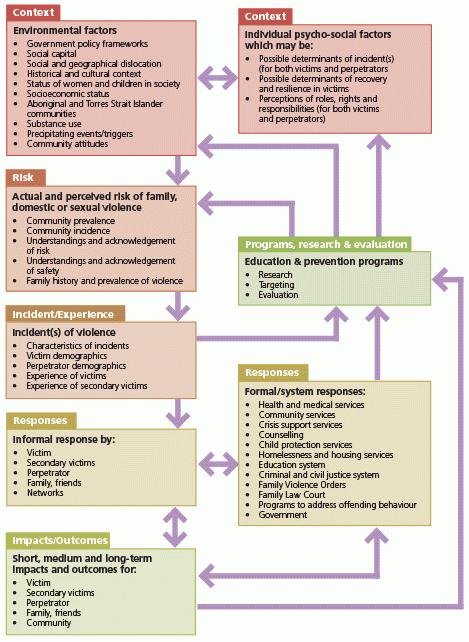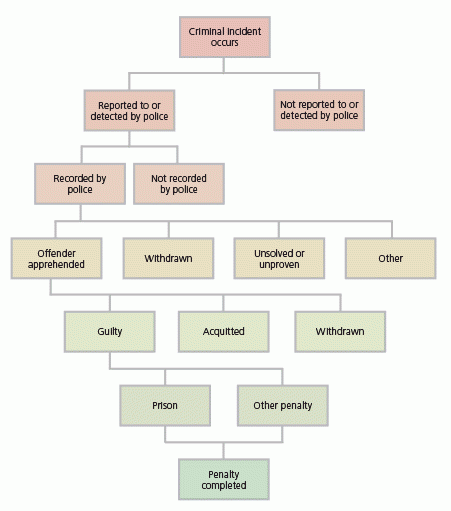Introduction
As Australia's national statistical agency, the Australian Bureau of Statistics (ABS) plays a central role in the production of information that supports government decision and policy-making, and coordination of the evidence base within the national statistical system. In doing so, the ABS not only collects and publishes data that describe the wellbeing of individuals and of society as a whole, but also develops tools such as conceptual frameworks and information development plans to support the further development of data in particular areas of statistics.
In 2005 the ABS released its National Information Development Plan for Crime and Justice Statistics (NIDP), 2005 (cat. no. 4520.0), developed in collaboration with key stakeholders in criminal justice. One of the agreed priorities specified in the NIDP was to develop an evidence base that would inform the criminal justice system response to family and domestic violence, and support the development of prevention and intervention strategies to decrease its incidence and prevalence.
This publication seeks to consolidate and update the work accomplished in two previous Information Papers; The Sexual Assault Information Development Framework, 2004 (cat. no 4518.0) and The Conceptual Framework for Family and Domestic Violence, 2009 (cat. no. 4529.0). The creation of this publication provides the foundation for future work to build an evidence base for family, domestic and sexual violence.
Laying the foundations - defining the data challenge for family, domestic and sexual violence
Aims of this publication
Defining the data challenge for family, domestic and sexual violence is a tool for policy and data experts, as well as researchers and service providers with an interest in family, domestic and sexual violence in Australia. It presents statistical and conceptual information relating to family, domestic and sexual violence, describing the main concepts, sources and priorities in this field. It also incorporates strategies for information development to address priority information needs relating to family, domestic and sexual violence.
This is a supporting document for a long term project to improve the evidence base, outlined in the National Plan to Reduce Violence against Women and their Children, 2010-2022 (the National Plan) and aims to improve the information available to support research, policy development, operational decision-making, education and community awareness activities into the future.
Defining the data challenge outlines and describes the social phenomena of family, domestic and sexual violence and aims to translate it into a statistically measurable context by:
- explaining the definitional and collection challenges associated with family, domestic and sexual violence data;
- identifying and organising key statistically measurable elements of family, domestic and sexual violence; and
- highlighting the related research and policy information needs applicable to family, domestic and sexual violence.
It is expected that this publication will contribute to policy development and service delivery planning by facilitating a common language that accurately and reliably measures statistics in this field. The multi-dimensional nature of family, domestic and sexual violence, and the development of legal and service responses to the problem over time, have led to a variety of definitions and a lack of comprehensive quality data to support effective evidence-based policy, services and responses for victims and perpetrators.
The short to medium-term aim is to assist in the determination of the key information priorities and understand the current data environment. This involves undertaking environmental and data gap analysis exercises to more effectively understand where the data needs are, and determine a course of action to address these needs.
A long-term aim of the National Plan is to create nationally consistent data definitions and collection methods to provide a fit-for-purpose, rich and flexible evidence base to meet current and future needs across the field. These needs may relate to topics ranging from primary prevention, understanding prevalence and incidence, to responses and service provision.
Policy context - the National Plan to Reduce Violence against Women and their Children
The Commonwealth established the National Council to Reduce Violence against Women and their Children (NCRVWC) in May 2008 to advise government on measures to reduce the incidence and impact of violence against women and their children. In response, the National Council developed the report Time for action: The National Council’s Plan for Australia to Reduce Violence against Women and their Children, 2009-2021 (NCRVWC 2009a). This report outlines the evidence-based plan, identifying six outcome areas and strategies for delivery, noting the crucial role of quality data to support evidence-based decision-making, and the need to further develop data in this field.
The Time for Action report and the Council of Australia Governments (COAG) National Plan to Reduce Violence against Women and their Children is comprised of a range of initiatives to address the report recommendations. This includes the establishment of a National Centre for Excellence which will bring together existing research and undertake new research on family, domestic and sexual violence. The report also recommends the development of a data collection and reporting framework, and a series of four three-yearly action plans with associated monitoring and reporting to drive the plan.
Building an evidence base
The plan to develop an improved evidence base will occur in concert with a range of other National Plan initiatives. The outcomes will assist a range of sectors with a remit to address family, domestic and sexual violence, such as health, education, civil and criminal justice, community services, housing and employment.
It is anticipated that many of the outcomes of the project, such as informing future policy questions and assisting in planning prevention, intervention and operational responses will be realised in the long-term. Short to medium-term outcomes of improved information and more streamlined data collection and presentation may be realised during the project, however, and in turn may influence other activities under the future National Plan action plans.
Phase one of this evidence base building project involves a range of activities to support strategic targeting of data development efforts throughout the life of the National Plan. This will enable a coordinated approach to information development effort across the Commonwealth, states and territories and the non-government sector. Defining the data challenge for family, domestic and sexual violence is the first deliverable in phase one, and will assist in forming future phases including the national data collection and reporting framework.
The national data collection and reporting framework will be comprised of the following:
- national data standards for key indicators and variables;
- shared understanding of data priorities and needs against a data collection framework and where to prioritise investment; and
- coordination of national and state/territory data collections (including existing surveys, and administrative by-product data sets) to improve coverage, reduce duplication, and comparability.
A coordinated and consolidated approach to data collection will guide the following:
- improved quality of priority areas of data: improved timeliness, accessibility, coherence, relevance, accuracy, interpretability;
- a strong collaborative network of data custodians in the fields of sexual assault, family and domestic violence and related areas;
- exploration of the feasibility of statistical data integration and sharing to efficiently meet priority needs, should there be data needs not easily met through a single dataset;
- improved description and presentation of the evidence base for family, domestic and sexual violence, including appropriate metadata, definitions and caveats to enable informed use of data; and
- ethical collection, storage and presentation of information relating to those who have experienced family, domestic and sexual violence as victims, perpetrators and witnesses.
Publication outline
This chapter has introduced the background and policy context in relation to family, domestic and sexual violence together with the aims and provides an outline of the publication. Chapter 2 discusses the complexities involved in defining family, domestic and sexual violence. Chapter 3 describes the nature and function of Defining the data challenge as a tool for statistical measurement of family, domestic and sexual violence. Chapters 4-9 individually scope each element in terms of its characteristics, related data, research and policy needs, measurement options and potential units for analysis. Chapter 10 provides a summary and discusses future developments.

